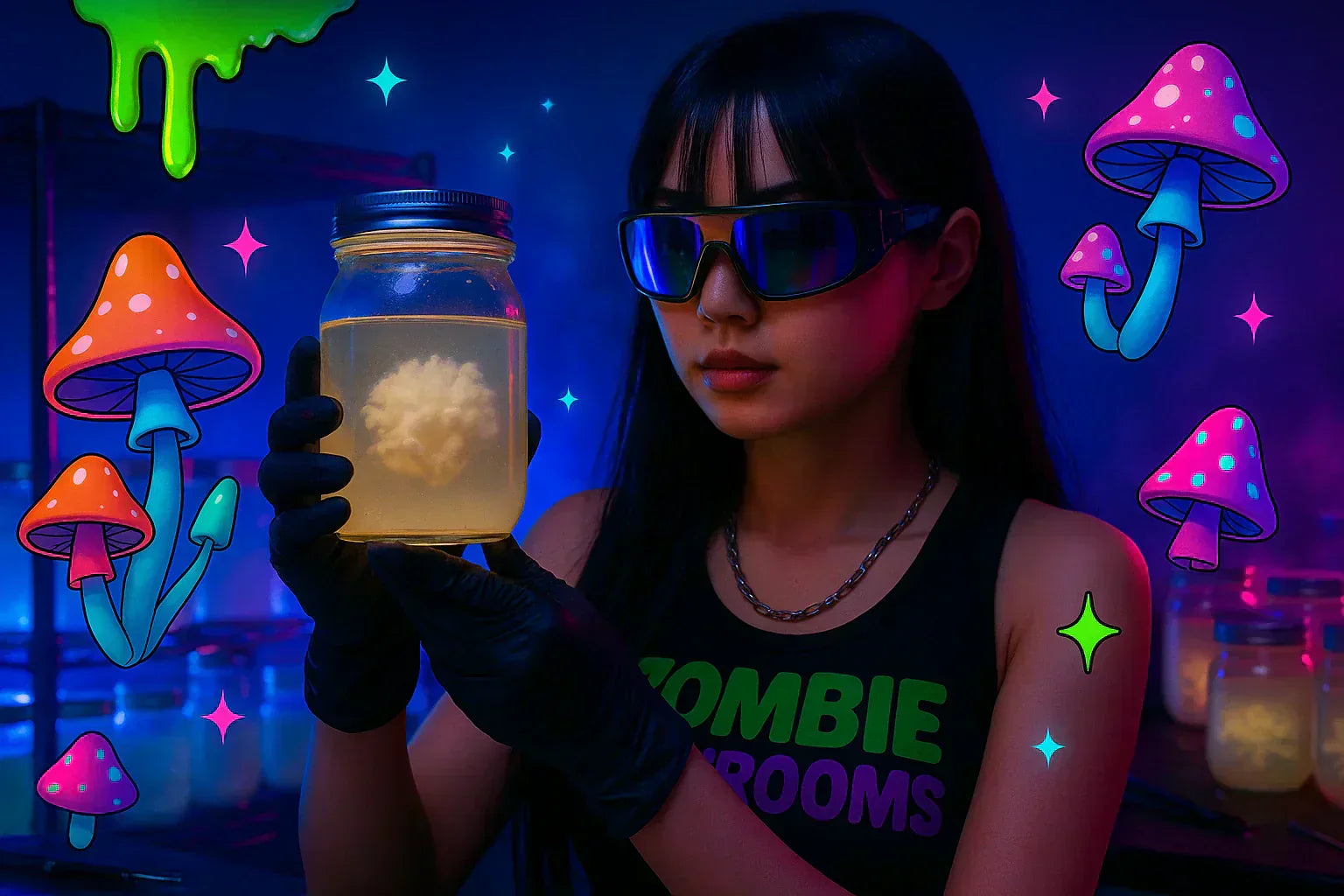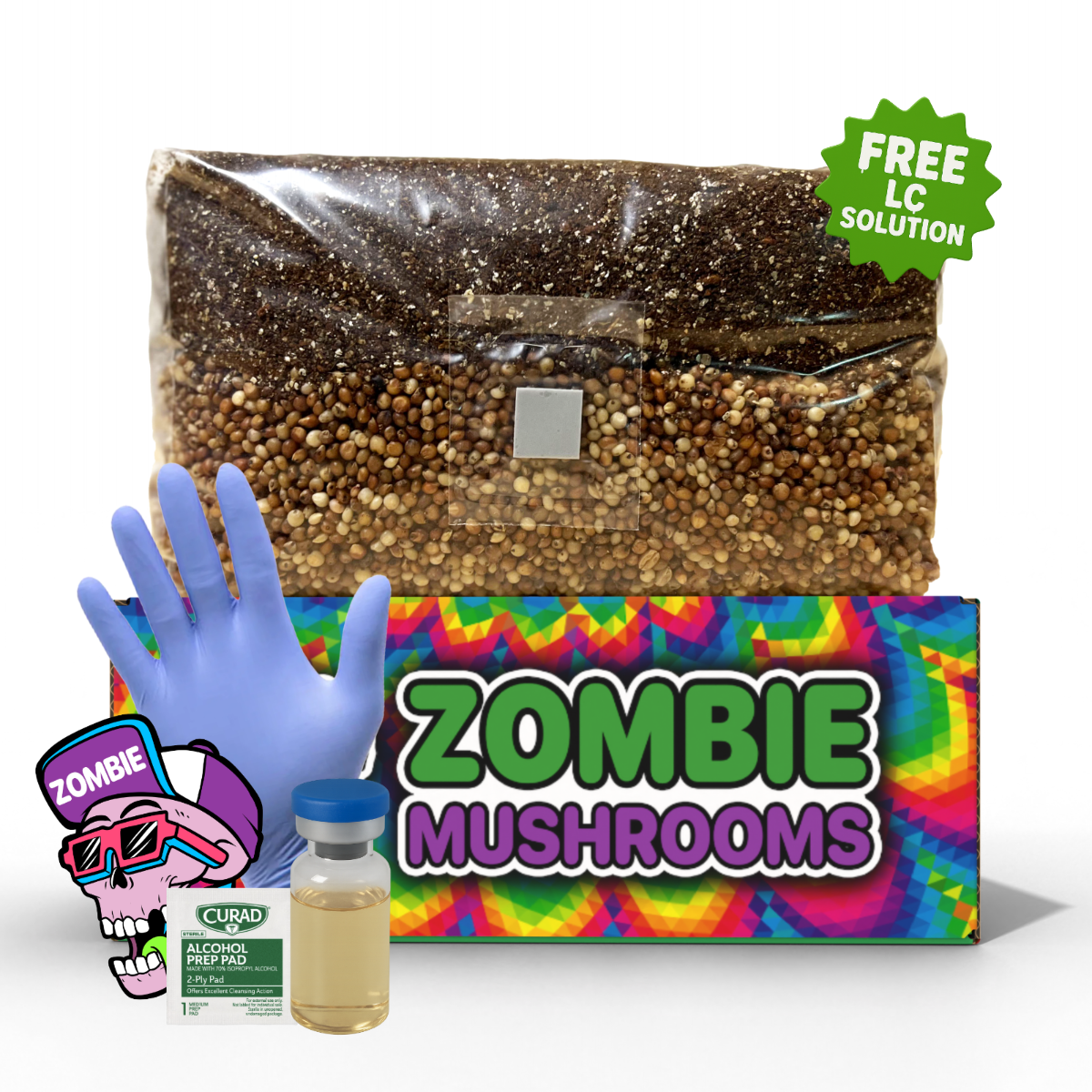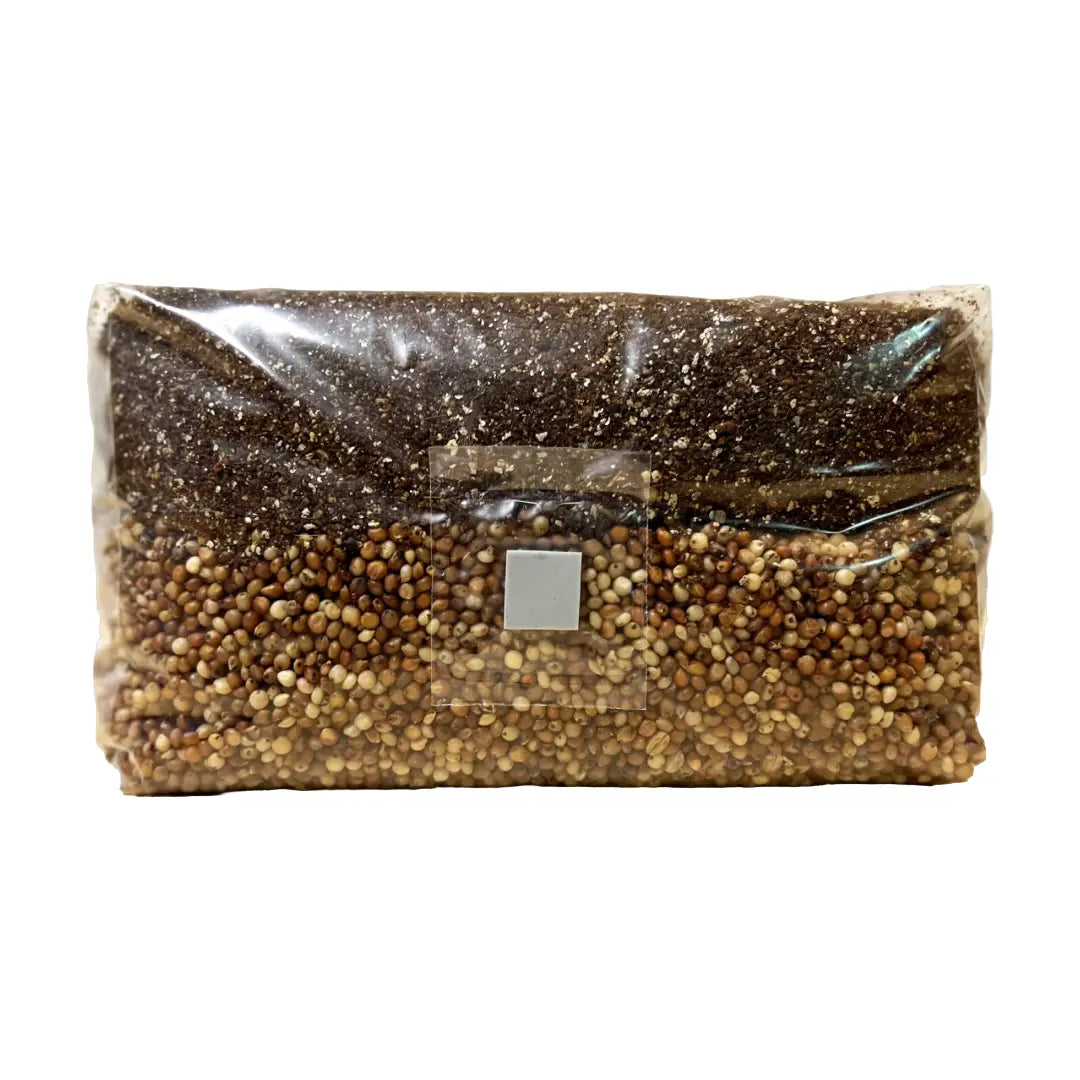⬇️ Prefer to listen instead? ⬇️
- 🍄 Liquid cultures reduce mushroom colonization time by up to 50% compared to spore syringes.
- 💧 Karo syrup provides an accessible glucose source that promotes strong mycelial growth.
- ⚠️ Contamination rates for amateur liquid cultures can reach 25% without proper sterile technique.
- 🧪 A 4% Karo syrup concentration balances growth promotion and contamination risk.
- 🌱 Karo liquid culture supports rapid growth for popular mushrooms like oyster, lion’s mane, and shiitake.
Karo Liquid Culture: Is It Good for Mushrooms?
Liquid culture (LC) is a powerful tool for mushroom growers, whether hobbyists or professionals. It lets you skip the slow process of spore germination. You can jump straight into growing mycelium that grows fast. Karo liquid culture, a simple mix of corn syrup and water, is an affordable and effective way to make LC at home. This makes it good for those new to mushroom growing. To put your LC to work, our mushroom grow bags provide a clean and reliable environment where your mycelium can colonize and produce strong harvests.

What Is a Liquid Culture (LC)?
A liquid culture is a nutrient-rich solution made to grow mycelium. Mycelium is the part of a fungus that grows like roots. Agar plates mean you transfer spores to a gel medium. But liquid culture speeds up the process. It does this by putting mycelium that has already germinated into a sugar-water mix. This offers a big plus: mycelium in LC is ready to colonize a substrate right away. Spores, on the other hand, must first germinate.
Paul Stamets (2000), a mycologist, said that using a liquid culture can cut colonization time by 30–50% compared to spore syringes. This makes LCs an efficient, time-saving way to grow more. For commercial or serious home growers, liquid cultures also give steady growth and results that can be repeated. This helps make yields more predictable.

Why Use Karo Syrup as a Liquid Culture Medium?
Karo syrup is a type of light corn syrup. It is mainly made from glucose. This makes it a good carbon source for mushroom liquid cultures. Fungi grow well on simple sugars like glucose. These sugars are the main building block for cell energy.
Advantages of Karo Syrup in LC:
- Easy to Find: You can get it at almost any grocery store.
- Affordable: One bottle lasts for many batches.
- Steady: Honey or molasses change depending on where they come from. But Karo syrup offers a standard glucose amount.
- Few Additives: Light Karo syrup has few or no preservatives. This lowers the chance of contamination.
Look at other LC ingredients like malt extract or honey. Karo stands out because it is simple and easy to get. Honey might have natural things that stop bacteria or wild yeast that mess up fungal growth. Malt extract has more nutrients, but it needs more precise work and costs more. For mushroom growing beginners, Karo offers a good mix of working well and being easy to use.

How Karo Liquid Culture Works
When fungal mycelium goes into a sterile sugar-water mix, it immediately starts to use the sugars. This activity helps it spread fast through the liquid. Karo syrup has a lot of glucose, which gives an energy source that is easy to digest. Chang and Miles (2004) confirmed that fungal mycelium quickly takes in and uses simple carbohydrates, especially glucose.
Just like too much sugar can harm humans, it can harm mushrooms too. Too much sugar in liquid culture can make fungal growth weak, upset the water balance, and make contamination more likely. Studies and what growers generally agree on point to a 4% sugar amount as the best for strong growth with a manageable risk of contamination.
Sugar Balance is Key:
- 🧪 Too Little: Slower growth, not enough nutrients.
- 🚫 Too Much: Osmotic shock, bacterial blooms, culture failure in time.

Step-by-Step Karo Liquid Culture Recipe
Making your own liquid culture at home does not need a lab space. It just takes proper steps, the right tools, and an eye for being clean.
Supplies Needed:
- Karo light corn syrup (no added vanilla or preservatives)
- Distilled water (do not use tap water because of possible chlorine or contaminants)
- Glass mason jars (250–500 ml) with self-healing injection ports and filter lids
- Pressure cooker (better) or a deep boiling pot
- Inoculation tools: spore syringe / agar wedge / mycelium syringe
- Still-air box (SAB) or glove box for clean work
Karo Liquid Culture Recipe:
-
Mix Ingredients:
- Put 4 ml of Karo syrup into every 100 ml of distilled water (so, 40 ml syrup for 1 liter water).
- Mix well until the syrup is fully dissolved.
-
Fill Jars:
- Pour the mix into mason jars. Fill them about 70% full. This leaves room for shaking and air movement.
-
Seal and Sterilize:
- If using a pressure cooker: Sterilize at 15 PSI for 20–25 minutes.
- If boiling: Put sealed jars in a rolling boil for 45–60 minutes. Note: This is not as effective as pressure cooking, and the risk of contamination is higher.
-
Cool Down:
- Let all jars cool completely to room temperature before inoculation. Hot liquid can kill spores or mycelium.
Inoculation:
In a clean space like a SAB or glove box:
- Clean the injection port and your tools (for example, flame-sterilize your needle).
- Carefully put spores or a mycelium wedge through the port. Never open the jar all the way.
- Seal again and shake gently to spread the mycelium you put in.
Monitoring and Storing Karo LC
What Healthy Growth Looks Like:
- Cloudy, rope-like strands (“mycelial snot”) show good colonization.
- Milky swirls or white clumps floating around are typical of mycelia that are actively growing.
- Growth usually appears within 5–10 days at the best temperatures, depending on the mushroom type.
Good Conditions for Storage:
- Temperature: 75–80°F (24–27°C) is great for most fungi.
- Lighting: Dark places (cupboards, drawers) stop breakdown and early pinning.
- Fridge Storage: Once grown, put your liquid culture in the fridge. This slows growth and makes shelf life longer. It usually lasts 2–6 months.
Do not shake hard before a lot of mycelium forms. Once it is growing well, swirl gently every few days to break up clumps and help get even distribution.

Avoiding Contamination: Best Cleanliness Practices
Being clean is a must for liquid culture. Contaminants—especially bacteria and wild molds—can quickly take over fungal growth.
Largeteau & Savoie (2010) found that hobby growers report contamination rates up to 25%. This is mainly due to bad sterilization or handling steps.
Clean Tips for Success:
- Always clean tools with 70% isopropyl alcohol.
- Flame sterilize needles right before injection.
- Make or buy a Still Air Box (SAB) to do inoculations in a closed, low-airflow space.
- Use gloves and a mask to lessen airborne dust.
- Check often for signs of contamination (cloudiness without growth, sour or bad smells, color changes).
If a jar is compromised, throw it out. Never try to save a contaminated LC. It is not worth the risk to your grow setup.

What Mushrooms Work Best With Karo LC?
Most gourmet and medicinal mushrooms do well with a glucose-rich LC. But some types grow especially well in Karo-based liquids:
-
Oyster Mushrooms (Pleurotus spp.)
These fast colonizers love simple sugars and are very easy for beginners. They show fast, fluffy growth. -
Shiitake (Lentinula edodes)
These are a bit slower to colonize but produce a lot when properly grown. A clean LC is very important. -
Lion’s Mane (Hericium erinaceus)
These are sensitive to contamination. But they grow well in simple nutrient solutions with good hygiene. -
Reishi (Ganoderma lucidum)
This type does well with glucose-based cultures. It needs slightly warmer growing conditions. -
Psilocybe cubensis (where legal)
This type works very well with Karo LCs, if careful clean methods are used.

Tips to Get the Most Growth From Karo LC
- 🧼 Cleanliness is key. Clean everything before touching your culture.
- ⏳ Label every jar with the date inoculated, mushroom type, and method. This helps you keep notes on results.
- 💨 Use vented filter lids to allow air movement while keeping contaminants out.
- 🔄 Swirl, do not shake hard, especially in early growth stages.
- ❄️ Store grown LCs in the fridge. But warm them up to room temperature before use.

When and How to Use Karo LC in Your Grow
Once you have a visibly healthy, grown culture, it is time to start putting it into your substrates. Liquid cultures are good for:
- Grain Spawn Bags: Inject right into pre-sterilized bags through the injection port.
- Grain Jars: Use clean syringes to move LC into sterilized grain to grow more.
- Grow Kits: Many store-bought kits have injection ports for easy LC use.
- Bulk Substrate Projects (for example, monotubs): After making grain spawn from LC, mix it with bulk substrates for big yields.
Zombie Mushroom offers grow kits that work with LC. They have injection-ready ports and filter patches. This takes away many starting barriers.

Pros and Cons of Karo Liquid Culture
✅ Pros:
- Cheap and easy to find.
- Simple to make with things you have at home.
- Fast colonization and growth rates.
- Long shelf life if refrigerated correctly.
❌ Cons:
- Higher chance of contamination if cleaning is not perfect.
- Fewer small nutrients compared to malt or yeast extract LC formulas.
- Not good for all species. Some may eventually need special solutions.

How Karo LC Compares to Other Liquid Culture Recipes
| Medium | Sugar Source | Nutritional Value | Cost | Contamination Risk | Best Used For |
|---|---|---|---|---|---|
| Karo Syrup | Glucose | Low | Low | Moderate | Beginners, fast-growing species |
| Honey | Fructose/Glucose | Medium | Moderate | High (not sterilized) | Mushroom type growing |
| Malt Extract | Maltose | High | Moderate+ | Low (lab-grade) | Nutrient-heavy species, pro grows |
| Dextrose | Pure Glucose | Medium | Moderate–High | Low | Trial and bigger setups |
For hobbyists, Karo syrup finds the right balance between being simple and working well. More advanced growers might want to try out complex recipes (like malt/yeast blends) for specific mushroom types.
Frequently Asked Questions About Karo LC
Can I reuse leftover LC after inoculation?
No. Once LC is open to air or unclean surfaces, the risk of contamination goes up a lot. Only store original, untouched jars.
My culture is cloudy, but no mycelium. What happened?
This usually means bacterial contamination. Throw it out right away.
How long do I wait after inoculating an LC jar?
You should see growth in 3–10 days under good conditions.
Do I need a stir plate or magnetic stir bar?
These help mix nutrients evenly and break up clumps. But they are not strictly needed for small home grows.
Can I use tap water instead of distilled?
It is not a good idea. Tap water may have chlorine or contaminants that stop fungal growth.
Troubleshooting Karo LC
| Symptom | Likely Cause | Solution |
|---|---|---|
| Cloudy liquid, no mycelium | Bacterial contamination | Discard, clean very well |
| No growth after 10 days | Dead spores or liquid that was too hot | Inoculate again with living culture |
| Thick blobs or jelly-like mass | Too much Karo syrup | Dilute to 4%, start batch again |
| Yellow tint or sour smell | Contamination by bacteria or yeast | Discard right away |
Make sure to do a sniff and visual test before use. Healthy LC has no strong smell and should look clean, white, and stringy.
Is Karo LC Good for Mushroom Cultivation?
Yes, it is. For beginner or intermediate mushroom growers, Karo liquid culture gives a simple, easy way to get strong fungal mycelium. When made and handled right, it helps quickly colonize substrate. It also cuts down on costly grow failures and supports good harvests. More advanced growers may try out different LC recipes. But Karo LC is hard to beat for its low cost, ease of use, and overall effectiveness.
You might be growing lion’s mane in your kitchen or getting oyster spawn ready in your garage. Either way, Karo LC stays one of the best places to start in DIY mushroom growing.
Citations
- Chang, S. T., & Miles, P. G. (2004). Mushrooms: Cultivation, Nutritional Value, Medicinal Effect, and Environmental Impact (2nd ed.). CRC Press.
- Stamets, P. (2000). Growing Gourmet and Medicinal Mushrooms (3rd ed.). Ten Speed Press.
- Largeteau, M. L., & Savoie, J. M. (2010). Microbiological quality and safety of ready-to-eat edible fungi: A review. Critical Reviews in Microbiology, 36(3), 165–179. https://doi.org/10.3109/10408410902902135



